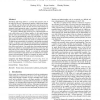Free Online Productivity Tools
i2Speak
i2Symbol
i2OCR
iTex2Img
iWeb2Print
iWeb2Shot
i2Type
iPdf2Split
iPdf2Merge
i2Bopomofo
i2Arabic
i2Style
i2Image
i2PDF
iLatex2Rtf
Sci2ools
ISSTA
2012
ACM
2012
ACM
A human study of patch maintainability
Identifying and fixing defects is a crucial and expensive part of the software lifecycle. Measuring the quality of bug-fixing patches is a difficult task that affects both functional correctness and the future maintainability of the code base. Recent research interest in automatic patch generation makes a systematic understanding of patch maintainability and understandability even more critical. We present a human study involving over 150 participants, 32 real-world defects, and 40 distinct patches. In the study, humans perform tasks that demonstrate their understanding of the control flow, state, and maintainability aspects of code patches. As a baseline we use both human-written patches that were later reverted and also patches that have stood the test of time to ground our results. To address any potential lack of readability with machine-generated patches, we propose a system wherein such patches are augmented with synthesized, human-readable documentation that summarizes thei...
Distinct Patches | Functional Correctness | ISSTA 2012 | Software Engineering | Software Engineering Metrics |
| Added | 28 Sep 2012 |
| Updated | 28 Sep 2012 |
| Type | Journal |
| Year | 2012 |
| Where | ISSTA |
| Authors | Zachary P. Fry, Bryan Landau, Westley Weimer |
Comments (0)

